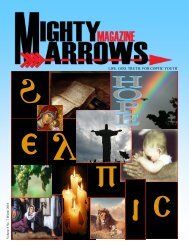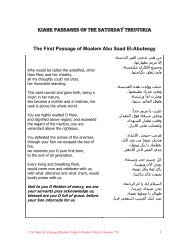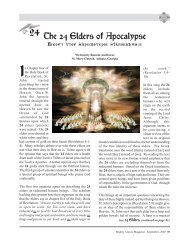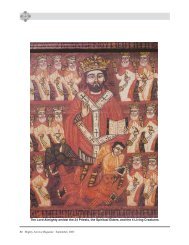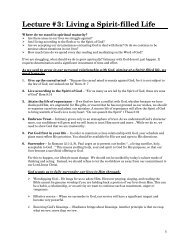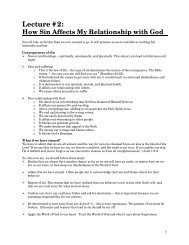Implication of the Concept of Perichoresis
Implication of the Concept of Perichoresis
Implication of the Concept of Perichoresis
Create successful ePaper yourself
Turn your PDF publications into a flip-book with our unique Google optimized e-Paper software.
“Believe Me that I am in <strong>the</strong> Fa<strong>the</strong>r and <strong>the</strong> Fa<strong>the</strong>r in Me.” (Jn 14:11)<br />
Lecture IX: <strong>Implication</strong>s <strong>of</strong> <strong>the</strong> <strong>Concept</strong> <strong>of</strong> <strong>Perichoresis</strong> <br />
<strong>Perichoresis</strong> & <strong>the</strong> wholeness <strong>of</strong> <strong>the</strong> Holy Trinity:<br />
<strong>Perichoresis</strong> reinforces <strong>the</strong> fact that <strong>the</strong> Holy Trinity may be known only as a whole for it is as a<br />
whole that God makes Himself known to us through Himself and in Himself as Fa<strong>the</strong>r, Son and Holy Spirit.<br />
It enables us to appreciate more fully <strong>the</strong> truth that <strong>the</strong> Holy Trinity is completely self-grounded in His own<br />
ultimate Reality, and that God’s self-revelation is self-enclosed and may be known and interpreted only on<br />
its own ground and out <strong>of</strong> itself. This mean that our knowing <strong>of</strong> God engages in a deep circular movement<br />
from Unity to Trinity and from Trinity to Unity, since we are unable to speak <strong>of</strong> <strong>the</strong> whole Trinity without<br />
already speaking <strong>of</strong> <strong>the</strong> three particular Persons <strong>of</strong> <strong>the</strong> Trinity or to speak <strong>of</strong> any <strong>of</strong> <strong>the</strong> three Persons without<br />
presuming knowledge <strong>of</strong> <strong>the</strong> whole Triunity, for God is God only as He is Fa<strong>the</strong>r, Son and Holy Spirit, and<br />
cannot be conceived by us truly o<strong>the</strong>rwise.<br />
The inner reason for this circular and holistic apprehension <strong>of</strong> God in His Triunity is already evident<br />
in <strong>the</strong> completely homoousial interrelations <strong>of</strong> <strong>the</strong> Fa<strong>the</strong>r, <strong>the</strong> Son and <strong>the</strong> Holy Spirit in which as distinct<br />
Hypostases <strong>the</strong>y share equally, individually and toge<strong>the</strong>r, and are <strong>the</strong> one identical Being <strong>of</strong> <strong>the</strong> Lord God<br />
Almighty. But it is in <strong>the</strong> refining and developing <strong>of</strong> <strong>the</strong> homoousion in its application to <strong>the</strong> Holy Trinity as<br />
a whole through <strong>the</strong> concept <strong>of</strong> perichoresis that this became fully confirmed, in realization <strong>of</strong> <strong>the</strong> truth that<br />
no divine Person is He who He really and truly is, even in His distinctive o<strong>the</strong>rness, apart from His relation<br />
to <strong>the</strong> o<strong>the</strong>r two in <strong>the</strong>ir mutual containing or interpenetrating <strong>of</strong> one ano<strong>the</strong>r in such a way that each Person<br />
is in Himself whole God <strong>of</strong> whole God. Since each divine Person considered in Himself is true God <strong>of</strong> true<br />
God without any qualification, <strong>the</strong> whole God dwells in each Person and each Person is whole God. Since<br />
<strong>the</strong> fullness <strong>of</strong> <strong>the</strong> Godhead is complete in each <strong>of</strong> <strong>the</strong>m as well as in all <strong>of</strong> <strong>the</strong>m, it is as <strong>the</strong> one indivisible<br />
Holy Trinity that God is God and that God is one God, and <strong>the</strong>refore may be known and is actually and truly<br />
known only as a Triune Whole.<br />
No one Person is knowable or known apart from <strong>the</strong> o<strong>the</strong>rs. Due to <strong>the</strong>ir perichoretic relations with<br />
one ano<strong>the</strong>r in which <strong>the</strong>y have <strong>the</strong>ir Being in one ano<strong>the</strong>r, <strong>the</strong> Fa<strong>the</strong>r is not truly known apart from <strong>the</strong> Son<br />
and <strong>the</strong> Holy Spirit; <strong>the</strong> Son is not truly known apart from <strong>the</strong> Fa<strong>the</strong>r and <strong>the</strong> Holy Spirit; and <strong>the</strong> Holy Spirit<br />
is not truly known apart from <strong>the</strong> Fa<strong>the</strong>r and <strong>the</strong> Son. The Holy Trinity is revealed and is known only as an<br />
indivisible Whole, in Trinity and Unity, Unity and Trinity. This indivisible wholeness must be allowed to<br />
govern our understanding <strong>of</strong> <strong>the</strong> inexpressible divine begotteness and procession <strong>of</strong> <strong>the</strong> Son and <strong>the</strong> Spirit<br />
from <strong>the</strong> Monarchy which, without a lapse into remnant <strong>of</strong> Origenist subordinationism, cannot be limited to<br />
<strong>the</strong> Fa<strong>the</strong>r. The Fa<strong>the</strong>r is not properly Fa<strong>the</strong>r apart from <strong>the</strong> Son and <strong>the</strong> Holy Spirit, <strong>the</strong> Son is not properly<br />
Son apart from <strong>the</strong> Fa<strong>the</strong>r and <strong>the</strong> Holy Spirit, and <strong>the</strong> Holy Spirit is not properly <strong>the</strong> Holy Spirit apart from<br />
<strong>the</strong> Fa<strong>the</strong>r and <strong>the</strong> Son.<br />
<strong>Perichoresis</strong> & <strong>the</strong> Divine Monarchy:<br />
<strong>Perichoresis</strong> has far-reaching implications for our understanding <strong>of</strong> <strong>the</strong> divine Monarchia. We saw<br />
above that perichoresis reinforces <strong>the</strong> fact that <strong>the</strong> Holy Trinity may be known only as a whole, for it is as a<br />
whole that God makes Himself known to us through Himself and in Himself as Fa<strong>the</strong>r, Son and Holy Spirit.<br />
This means that we understand <strong>the</strong> Monarchy <strong>of</strong> God not in a partitive way moving linearly, as it were, from<br />
one divine Person to ano<strong>the</strong>r, but in <strong>the</strong> same holistic way as we know <strong>the</strong> Holy Trinity, although we may<br />
develop modes <strong>of</strong> thought and speech with which to bring out <strong>the</strong> distinctive individualities and objectives <strong>of</strong><br />
<strong>the</strong> three divine Persons, as <strong>the</strong> Cappadocian Fa<strong>the</strong>rs sought to do while seeking to steer a way between <strong>the</strong><br />
extremes <strong>of</strong> unipersonalism and trithiesim.<br />
St. Athanasius, however, held that since <strong>the</strong> whole Godhead is in <strong>the</strong> Son and in <strong>the</strong> Spirit, <strong>the</strong>y must<br />
be included with <strong>the</strong> Fa<strong>the</strong>r in <strong>the</strong> one originless Source or Arche <strong>of</strong> <strong>the</strong> Holy Trinity (Ad Antiochenos, 5;<br />
80
Contra. Arianos, 4.1-4) For St. Athanasius <strong>the</strong> concept <strong>of</strong> Triunity was embedded in his understanding <strong>of</strong> <strong>the</strong><br />
homoousion which, with its rejection <strong>of</strong> any notion ei<strong>the</strong>r <strong>of</strong> undifferentiated oneness or <strong>of</strong> partitive relations<br />
between <strong>the</strong> three divine Persons, carried with it <strong>the</strong> conception <strong>of</strong> eternal distinctions and internal relations<br />
in <strong>the</strong> Godhead as wholly and mutually indwelling one ano<strong>the</strong>r in <strong>the</strong> one identical perfect Being <strong>of</strong> <strong>the</strong><br />
Fa<strong>the</strong>r, <strong>the</strong> Son and <strong>the</strong> Holy Spirit. It was through <strong>the</strong> Trinity, St. Athanasius held, that we believe in <strong>the</strong><br />
Unity <strong>of</strong> God, and yet it is only in recognition <strong>of</strong> <strong>the</strong> indivisible oneness and identity <strong>of</strong> Being in <strong>the</strong> Son and<br />
<strong>the</strong> Holy Spirit with <strong>the</strong> Fa<strong>the</strong>r that we rightly apprehend <strong>the</strong> Holy Trinity.<br />
It is in this very light that we are to understand how St. Athanasius regarded <strong>the</strong> divine Monarchia.<br />
He certainly thought <strong>of</strong> <strong>the</strong> Fa<strong>the</strong>r as <strong>the</strong> Arche but not <strong>the</strong> Cause <strong>of</strong> <strong>the</strong> Son in that He has eternally begotten<br />
<strong>the</strong> Son. He thus declared, ‘We know only one Arche’, but he immediately associated <strong>the</strong> Son with that<br />
Arche for he added, ‘we pr<strong>of</strong>ess to have no o<strong>the</strong>r Form <strong>of</strong> Godhead than that <strong>of</strong> <strong>the</strong> Only God’ (Contra<br />
Arianos, 1.14; 3.15) While <strong>the</strong> Son is associated with <strong>the</strong> Arche <strong>of</strong> <strong>the</strong> Fa<strong>the</strong>r in this way, He cannot be<br />
thought <strong>of</strong> as an Arche subsisting in Himself, for by His very Nature He is inseparable from <strong>the</strong> Fa<strong>the</strong>r <strong>of</strong><br />
whom He is <strong>the</strong> Son. By <strong>the</strong> same token, however, <strong>the</strong> Fa<strong>the</strong>r cannot be thought <strong>of</strong> as an Arche apart from<br />
<strong>the</strong> Son, for it is precisely as Fa<strong>the</strong>r that He is Fa<strong>the</strong>r <strong>of</strong> <strong>the</strong> Son. ‘The Fa<strong>the</strong>r and <strong>the</strong> Son are two, but <strong>the</strong><br />
Unity <strong>of</strong> Godhead is one and indivisible. And thus we preserve <strong>the</strong> one Arche <strong>of</strong> <strong>the</strong> Godhead, not two<br />
Archai, so that <strong>the</strong>re is strictly a Monarchia’ (Contra Arianos, 4.1; cf. 2-3)<br />
Thus while accepting along with <strong>the</strong> Cappadocian Fa<strong>the</strong>rs <strong>the</strong> formulation <strong>of</strong> One Being, Three<br />
Persons, St. Athanasius had such a strong view <strong>of</strong> <strong>the</strong> complete identity, equality and unity <strong>of</strong> <strong>the</strong> three<br />
divine Persons within <strong>the</strong> Godhead, that he declined to advance a view <strong>of</strong> <strong>the</strong> Monarchy in which <strong>the</strong> oneness<br />
<strong>of</strong> God was defined by reference to <strong>the</strong> Fa<strong>the</strong>r alone or to <strong>the</strong> Person <strong>of</strong> <strong>the</strong> Fa<strong>the</strong>r. In fact, for St. Athanasius<br />
as for St. Alexander, his predecessor as Archbishop <strong>of</strong> Alexandria, <strong>the</strong> idea that <strong>the</strong> Fa<strong>the</strong>r alone is Arche,<br />
Principle, Origin or source, in this sense was an Origenist concept that had become a main plank in Arian<br />
deviation from <strong>the</strong> apostolic and Catholic faith. (See letter <strong>of</strong> Arius to Eusebius, apud Theodoret, Historia<br />
ecclesiae, 1.4; Athanasius, De synodis, 16. Thus also Hilary, De Trinitate, 4.13, and Epiphanius, Haereses,<br />
69.8, 78; cf. also 73.16, 21) The Monarchy is identical with <strong>the</strong> Trinity, <strong>the</strong> Monad with <strong>the</strong> Triad, and it is<br />
precisely in <strong>the</strong> Triad that we know God to be Monad. St. Athanasius actually preferred to speak <strong>of</strong> God as<br />
Monad ra<strong>the</strong>r than Arche, since his understanding <strong>of</strong> <strong>the</strong> Monad was essentially as <strong>the</strong> Triad: God is eternally<br />
and unchangeably Fa<strong>the</strong>r, Son and Holy Spirit, three Persons who, while always Fa<strong>the</strong>r, Son and Holy Spirit,<br />
in <strong>the</strong>ir coindwelling relations are <strong>the</strong> Triune God.<br />
The Monarchia or <strong>the</strong> Monad is essentially and intrinsically Trinitarian in <strong>the</strong> inner relations <strong>of</strong> God’s<br />
eternal Ousia. An early statement attributed to St. Athanasius appears to represent his concept <strong>of</strong> <strong>the</strong> Triunity<br />
<strong>of</strong> God ra<strong>the</strong>r faithfully: ‘The Trinity praised and worshiped and adored, is one and indivisible, and without<br />
degrees. He is united without confusion, just as <strong>the</strong> Monad is distinguished in thought without division. For<br />
<strong>the</strong> threefold doxology, ‘Holy, Holy, Holy is <strong>the</strong> Lord’ <strong>of</strong>fered by those venerable living beings, denotes <strong>the</strong><br />
three perfect Persons just as in <strong>the</strong> word ‘Lord’ <strong>the</strong>y indicate his one Being.’<br />
When we turn to St. Epiphanius we find him taking essentially <strong>the</strong> same line, for he presented his<br />
doctrine <strong>of</strong> <strong>the</strong> Son and <strong>the</strong> Spirit within an understanding <strong>of</strong> <strong>the</strong> whole undivided Trinity, not just <strong>the</strong> Fa<strong>the</strong>r,<br />
as <strong>the</strong> Monarchia. He did not speak <strong>of</strong> <strong>the</strong> three divine Persons as ‘modes <strong>of</strong> existence’, like St. Basil and St.<br />
Gregory Nyssen, but as ‘enhypostatic’ in God, that is, having real, objective personal subsistence in God as<br />
coinhering homoousially and hypostatically in Him. His conception <strong>of</strong> <strong>the</strong> homoousion as applying to <strong>the</strong><br />
Holy Trinity as a whole deepened <strong>the</strong> notion <strong>of</strong> <strong>the</strong> coinherence <strong>of</strong> <strong>the</strong> Fa<strong>the</strong>r, <strong>the</strong> Son and <strong>the</strong> Holy Spirit in<br />
<strong>the</strong>ir subsistent enhypostatic relations. Moreover, he did not share <strong>the</strong> Cappadocian way <strong>of</strong> trying to ensure<br />
<strong>the</strong> unity <strong>of</strong> God by tracing it back to <strong>the</strong> one uncaused or underived Person <strong>of</strong> <strong>the</strong> Fa<strong>the</strong>r. He held that <strong>the</strong><br />
whole Trinity, and not just <strong>the</strong> Fa<strong>the</strong>r, to be <strong>the</strong> Principle or Arche <strong>of</strong> <strong>the</strong> oneness <strong>of</strong> <strong>the</strong> Godhead.<br />
81
Hence he laid immense emphasis upon <strong>the</strong> full equality, perfection, eternity, power and glory <strong>of</strong> <strong>the</strong><br />
Fa<strong>the</strong>r, <strong>the</strong> Son and <strong>the</strong> Holy Spirit alike, and thus upon <strong>the</strong> perfection <strong>of</strong> God’s Triunity. Each <strong>of</strong> <strong>the</strong> divine<br />
Persons is fully, equally and perfectly Lord and God while all three have and are one and <strong>the</strong> same Godhead.<br />
As St. Augustine wrote, ‘There is so great an equality in <strong>the</strong> Trinity, that not only <strong>the</strong> Fa<strong>the</strong>r is not greater<br />
than <strong>the</strong> Son, as regards divinity, but nei<strong>the</strong>r are <strong>the</strong> Fa<strong>the</strong>r and <strong>the</strong> Son toge<strong>the</strong>r greater than <strong>the</strong> Holy Spirit;<br />
nor is each individual Person, which ever He be <strong>of</strong> <strong>the</strong> three, less than <strong>the</strong> Trinity Himself.’<br />
It is noteworthy to point out that St. Gregory Nazianzen insisted that <strong>the</strong> Monarchia may not be<br />
limited to one Person, he said, ‘Monarchy is that which we hold in honor. It is however, a monarchy that is<br />
not limited to one Person, but one which is made <strong>of</strong> an equality <strong>of</strong> Nature and a Union <strong>of</strong> mind, and an<br />
identity <strong>of</strong> motion, and a convergence <strong>of</strong> its elements to Unity – a thing which is impossible to <strong>the</strong> created<br />
being – so that though numerically distinct <strong>the</strong>re is no severance <strong>of</strong> Essence.’ (3 rd Theological Oration,<br />
article II, p.301)<br />
<strong>Perichoresis</strong> played a crucial role in clarifying and deepening <strong>the</strong> conception <strong>of</strong> <strong>the</strong> Monarchia for <strong>the</strong><br />
understanding <strong>of</strong> <strong>the</strong> interlocking <strong>of</strong> Unity and trinity, Trinity and Unity, in <strong>the</strong> Doctrine <strong>of</strong> God. It may be<br />
helpful to cite here a paragraph from a document <strong>of</strong> <strong>the</strong> Orthodox / Reformed Commission commenting on<br />
<strong>the</strong> Monarchia in this connection: “Of far-reaching importance is <strong>the</strong> stress laid upon <strong>the</strong> Monarchy <strong>of</strong> <strong>the</strong><br />
Godhead in which all three divine Persons share, for <strong>the</strong> whole indivisible Being <strong>of</strong> God belongs to each <strong>of</strong><br />
<strong>the</strong>m as it belongs to all <strong>of</strong> <strong>the</strong>m toge<strong>the</strong>r. This is reinforced by <strong>the</strong> unique conception <strong>of</strong> coinherent and<br />
perichoretic relations between <strong>the</strong> different Persons in which <strong>the</strong>y completely contain and interpenetrate one<br />
ano<strong>the</strong>r while remaining what <strong>the</strong>y distinctively are in <strong>the</strong>ir o<strong>the</strong>rness as Fa<strong>the</strong>r, Son and Holy Spirit. God is<br />
intrinsically Triune, Trinity in Unity and Unity in Trinity. There are no degrees <strong>of</strong> Deity in <strong>the</strong> Holy Trinity,<br />
as is implied in a distinction between <strong>the</strong> underived Deity <strong>of</strong> <strong>the</strong> Fa<strong>the</strong>r and <strong>the</strong> derived Deity <strong>of</strong> <strong>the</strong> Son and<br />
<strong>the</strong> Spirit. Any notion <strong>of</strong> subordination is completely ruled out. The perfect simplicity and indivisibility <strong>of</strong><br />
God in His Triune Being mean <strong>the</strong> Arche or Monarchia cannot be limited to one Person, as Gregory <strong>the</strong><br />
Theologian pointed out. While <strong>the</strong>re are inviolable distinctions within <strong>the</strong> Holy Trinity, this does not detract<br />
from <strong>the</strong> truth that <strong>the</strong> whole Being <strong>of</strong> God belongs to all <strong>of</strong> <strong>the</strong>m as it belongs to each <strong>of</strong> <strong>the</strong>m, and thus does<br />
not detract from <strong>the</strong> truth that <strong>the</strong> Monarchy is One and indivisible, <strong>the</strong> Trinity in Unity and <strong>the</strong> Unity in<br />
Trinity.” (Theological Dialogue between Orthodox and Reformed Churches, vol. 2)<br />
<strong>Perichoresis</strong> & Distinctions within <strong>the</strong> Holy Trinity:<br />
The concept <strong>of</strong> perichoresis deepens and streng<strong>the</strong>ns our understanding <strong>of</strong> <strong>the</strong> hypostatic distinction<br />
within <strong>the</strong> Holy Trinity. While it helps to clarify <strong>the</strong> circularity <strong>of</strong> our belief in <strong>the</strong> Trinity through belief in<br />
His Unity, and our belief in His Unity through belief in His Trinity, it does not dissolve <strong>the</strong> distinctions<br />
between <strong>the</strong> three divine Persons unipersonally into <strong>the</strong> one Being <strong>of</strong> God. On <strong>the</strong> contrary, it establishes<br />
those distinctions by showing that it is precisely through <strong>the</strong>ir reciprocal relations with one ano<strong>the</strong>r, and in<br />
virtue <strong>of</strong> <strong>the</strong>ir incommunicable characteristics as Fa<strong>the</strong>r, Son and Holy Spirit, that <strong>the</strong> three divine Persons<br />
constitute <strong>the</strong> very Communion which <strong>the</strong> one God eternally is, or which <strong>the</strong>y eternally are. In so doing,<br />
however, perichoresis has much to say about <strong>the</strong> order between <strong>the</strong> Fa<strong>the</strong>r, <strong>the</strong> Son and <strong>the</strong> Holy Spirit in<br />
<strong>the</strong>ir relations with one ano<strong>the</strong>r, <strong>the</strong> relation <strong>of</strong> <strong>the</strong> Fa<strong>the</strong>r to <strong>the</strong> Son as His Fa<strong>the</strong>r, and <strong>the</strong> relation <strong>of</strong> <strong>the</strong><br />
Holy Spirit to both as <strong>the</strong> Spirit <strong>of</strong> <strong>the</strong> Fa<strong>the</strong>r and <strong>the</strong> Spirit <strong>of</strong> <strong>the</strong> Son. They all coexist enhypostatically in<br />
<strong>the</strong> Communion <strong>of</strong> <strong>the</strong> Holy Trinity without being confused with one ano<strong>the</strong>r, and without differing from one<br />
ano<strong>the</strong>r in respect <strong>of</strong> <strong>the</strong>ir homoousial Being and homogenous Nature.<br />
On <strong>the</strong> one hand, perichoresis asserts <strong>the</strong> full equality <strong>of</strong> <strong>the</strong> three divine Persons. St. Gregory<br />
Nazianzen and St. Didymus <strong>the</strong> Blind drew <strong>the</strong> attention <strong>of</strong> <strong>the</strong> Early Church to <strong>the</strong> fact that in <strong>the</strong> triadic<br />
formulations in <strong>the</strong> Scriptures <strong>of</strong> <strong>the</strong> New Testament a variation in <strong>the</strong> order in which <strong>the</strong> divine Persons are<br />
mentioned is found, which points to <strong>the</strong>ir indivisible Nature and essential equality <strong>of</strong> Being. Moreover, <strong>the</strong><br />
New Testament refers to each Person, <strong>the</strong> Son and <strong>the</strong> Spirit no less than <strong>the</strong> Fa<strong>the</strong>r, as ‘Lord’ or Yahweh,<br />
each, <strong>the</strong>refore, as true God, as ‘whole God’, ‘whole from whole’ as St. Athanasius expressed it, or ‘God<br />
82
considered in Himself’, as St. Gregory Nazianzen expressed it. This represented a rejection <strong>of</strong> any Arian or<br />
partitive conceptions <strong>of</strong> Deity, and was considerably streng<strong>the</strong>ned by <strong>the</strong> concept <strong>of</strong> perichoresis without any<br />
detraction from <strong>the</strong> distinctive properties and interrelations <strong>of</strong> <strong>the</strong> three divine Persons, through <strong>the</strong> emphatic<br />
assertion, not only <strong>of</strong> <strong>the</strong>ir oneness in Being, but <strong>of</strong> <strong>the</strong>ir identity in will, authority, judgment, energy, power<br />
or any o<strong>the</strong>r divine attribute. In all but <strong>the</strong> incommunicable properties which differentiate <strong>the</strong>m from one<br />
ano<strong>the</strong>r as Fa<strong>the</strong>r, Son and Holy Spirit, <strong>the</strong>y share completely and equally – each <strong>of</strong> <strong>the</strong> divine Persons is<br />
entirely united to those with whom He is enjoined as He is with Himself because <strong>of</strong> <strong>the</strong> identity <strong>of</strong> Being and<br />
Power that is between <strong>the</strong>m. This was clearly affirmed at <strong>the</strong> Council <strong>of</strong> Constantinople before <strong>the</strong> adoption<br />
<strong>of</strong> perichoresis as a technical term, when it promulgated and enlarged <strong>the</strong> Nicene confession <strong>of</strong> Faith. Thus<br />
in taking <strong>the</strong>ir cue from <strong>the</strong> faith <strong>of</strong> Baptism in <strong>the</strong> Name <strong>of</strong> <strong>the</strong> Fa<strong>the</strong>r and <strong>the</strong> Son and <strong>the</strong> Holy Spirit, <strong>the</strong><br />
Fa<strong>the</strong>rs <strong>of</strong> Constantinople wrote in <strong>the</strong>ir Encyclical or Synodical Epistle, ‘According to <strong>the</strong> Faith <strong>the</strong>re is one<br />
Godhead, Power and Being <strong>of</strong> <strong>the</strong> Fa<strong>the</strong>r and <strong>of</strong> <strong>the</strong> Son and <strong>of</strong> <strong>the</strong> Holy Spirit, equal in Honor and Majesty<br />
and coeternal Sovereignty in three most perfect Hypostases, that is, in three perfect Persons.’ That was<br />
designed to set completely aside <strong>the</strong> twin heresies <strong>of</strong> Arianism and Sabellianism, or partitive and unipersonal<br />
conception <strong>of</strong> God, <strong>the</strong> very point that was taken up and made more precise by <strong>the</strong> perichoretic teaching <strong>of</strong><br />
Pseudo-Cyril and John Damascene.<br />
On <strong>the</strong> o<strong>the</strong>r hand, perichoresis affirms <strong>the</strong> real distinctions between <strong>the</strong> divine Persons in <strong>the</strong>ir<br />
hypostatic relations with one ano<strong>the</strong>r, as well as <strong>the</strong>ir real oneness, and does so by providing <strong>the</strong> frame<br />
within which we may think and speak <strong>of</strong> <strong>the</strong> three divine Persons in <strong>the</strong>ir proper differences without<br />
detracting from <strong>the</strong>ir complete equality, in line with <strong>the</strong> order given in Baptism into <strong>the</strong> name <strong>of</strong> <strong>the</strong> Fa<strong>the</strong>r,<br />
<strong>the</strong> Son, and <strong>the</strong> Holy Spirit – <strong>the</strong> Fa<strong>the</strong>r first, <strong>the</strong> Son second, <strong>the</strong> Spirit third. The priority in order or<br />
Monarchy <strong>of</strong> <strong>the</strong> Fa<strong>the</strong>r within <strong>the</strong> Trinitarian relations is in harmony with <strong>the</strong> Fa<strong>the</strong>r’s relation to <strong>the</strong> Son<br />
and <strong>the</strong> Spirit within <strong>the</strong> indivisibility <strong>of</strong> <strong>the</strong> Triune Being <strong>of</strong> God. It refers to <strong>the</strong> fact that <strong>the</strong> Son is begotten<br />
<strong>of</strong> <strong>the</strong> Fa<strong>the</strong>r, not <strong>the</strong> Fa<strong>the</strong>r <strong>of</strong> <strong>the</strong> Son. Thus in <strong>the</strong> Fa<strong>the</strong>r / Son relation <strong>the</strong> Fa<strong>the</strong>r is <strong>the</strong> Fa<strong>the</strong>r <strong>of</strong> <strong>the</strong> Son,<br />
He is in no sense <strong>the</strong> deifier <strong>of</strong> <strong>the</strong> Son, for He Himself in His eternal Being as God is not Fa<strong>the</strong>r without <strong>the</strong><br />
Son, as <strong>the</strong> Son in His eternal Being as God is not <strong>the</strong> Son without <strong>the</strong> Fa<strong>the</strong>r. That is to say, <strong>the</strong> inner<br />
Trinitarian order is not to be understood in an immanent differential way, for it does not apply to <strong>the</strong> Being<br />
or <strong>the</strong> Deity <strong>of</strong> <strong>the</strong> divine Persons which each individually and all toge<strong>the</strong>r have absolutely in common, but<br />
only to <strong>the</strong> mysterious ‘disposition or economy’ which <strong>the</strong>y have among <strong>the</strong>mselves within <strong>the</strong> unity <strong>of</strong> <strong>the</strong><br />
Godhead, distinguished by position and not status, by form and not being, for <strong>the</strong>y are fully and perfectly<br />
equal.<br />
A problem arose in <strong>the</strong> Cappadocian <strong>the</strong>ology <strong>of</strong> <strong>the</strong> post-Nicene era, due largely to <strong>the</strong>ir defense <strong>of</strong><br />
Nicene Orthodoxy against Aristotelianising argumentation <strong>of</strong> Eunomius <strong>the</strong> Arian Bishop <strong>of</strong> Cyzicus. The<br />
Cappadocian Fa<strong>the</strong>rs helped <strong>the</strong> Church to have a richer and fuller understanding <strong>of</strong> <strong>the</strong> three Persons <strong>of</strong> <strong>the</strong><br />
Holy Trinity in <strong>the</strong>ir distinctive ‘modes <strong>of</strong> existence’ or ways <strong>of</strong> origination, as St. Basil and his bro<strong>the</strong>r, but<br />
not St. Gregory Nazianzen, spoke <strong>of</strong> <strong>the</strong>m. They contributed considerably to <strong>the</strong> richly personal<br />
understanding <strong>of</strong> <strong>the</strong> Holy Trinity through <strong>the</strong>ir emphasis on <strong>the</strong> distinctive and objective existence, <strong>the</strong><br />
peculiar nature and characteristics <strong>of</strong> <strong>the</strong> Fa<strong>the</strong>r, <strong>the</strong> Son and <strong>the</strong> Holy Spirit as <strong>the</strong>y are made known to us in<br />
<strong>the</strong> Gospel, and as <strong>the</strong>y belong to one ano<strong>the</strong>r in <strong>the</strong> Communion which <strong>the</strong>y constitute toge<strong>the</strong>r as One<br />
Being, Three Person; that was a significant move for faith and worship. However, St. Basil considered that<br />
<strong>the</strong> defense <strong>of</strong> <strong>the</strong> Nicene <strong>the</strong>ology required a clear distinction to be made between Ousia and Hypostasis, for<br />
<strong>the</strong>ir identity could be used, and was used, though diversely, by Sabellians and Eunomians in support <strong>of</strong> <strong>the</strong>ir<br />
heretical unipersonal and subordinationist ideas. When <strong>the</strong> Cappadocian <strong>the</strong>ologians argued for <strong>the</strong> doctrine<br />
<strong>of</strong> one Being, three Persons <strong>the</strong>y did so on <strong>the</strong> ground that <strong>the</strong> ousia has <strong>the</strong> same relation to <strong>the</strong> hypostasis as<br />
<strong>the</strong> general or common to <strong>the</strong> particular. They accounted for <strong>the</strong> oneness and threeness <strong>of</strong> God through<br />
recourse to <strong>the</strong> dangerous analogy <strong>of</strong> <strong>the</strong> three different people having a common nature. They absorbed <strong>the</strong><br />
Nicene Ousia <strong>of</strong> <strong>the</strong> Fa<strong>the</strong>r into <strong>the</strong> Hypostasis <strong>of</strong> <strong>the</strong> Fa<strong>the</strong>r, and when <strong>the</strong>y spoke <strong>of</strong> <strong>the</strong> three divine<br />
Persons as having <strong>the</strong> same Being or Nature, <strong>the</strong>y were apt to identify ousia with physis or nature.<br />
83
Thereby <strong>the</strong>y tended to give ousia an abstract generic sense, which had <strong>the</strong> effect <strong>of</strong> making <strong>the</strong>m<br />
treat ousia or physis as impersonal. Then when in addition <strong>the</strong>y concentrated Christian faith directly upon <strong>the</strong><br />
three distinct Hypostases <strong>of</strong> <strong>the</strong> Fa<strong>the</strong>r, <strong>the</strong> Son, and <strong>the</strong> Holy Spirit as <strong>the</strong>y are united through <strong>the</strong>ir common<br />
action, <strong>the</strong>y were charged with thinking <strong>of</strong> God in a partitive or trithiestic way, three gods with a common<br />
nature, which <strong>of</strong> course <strong>the</strong>y rejected. They sought to meet this charge by establishing <strong>the</strong>ir belief in <strong>the</strong><br />
oneness <strong>of</strong> God through anchoring it in <strong>the</strong> Fa<strong>the</strong>r as <strong>the</strong> one Origin or Principle or Cause <strong>of</strong> divine Unity,<br />
and <strong>the</strong>y spoke <strong>of</strong> <strong>the</strong> Son and <strong>the</strong> Holy Spirit as deriving <strong>the</strong>ir distinctive modes <strong>of</strong> subsistence or coming<br />
into existence from <strong>the</strong> Fa<strong>the</strong>r as <strong>the</strong> Fount <strong>of</strong> Deity. Some went fur<strong>the</strong>r and argued that <strong>the</strong> Son and <strong>the</strong><br />
Spirit derive <strong>the</strong>ir being and indeed <strong>the</strong>ir Deity from <strong>the</strong> Fa<strong>the</strong>r by way <strong>of</strong> unique causation which comprises<br />
and is continuous with its effects, and by that <strong>the</strong>y meant <strong>the</strong> Fa<strong>the</strong>r considered as Person, i.e. as Hypostasis<br />
not Ousia, which represented a divergence from <strong>the</strong> teaching <strong>of</strong> <strong>the</strong> Nicene Council. Thus <strong>the</strong>y thought <strong>of</strong> <strong>the</strong><br />
relations between <strong>the</strong> Fa<strong>the</strong>r and <strong>the</strong> Son and <strong>the</strong> Holy Spirit as constituting a structure <strong>of</strong> a causal series or,<br />
as it were, ‘a chain <strong>of</strong> dependence’. And <strong>the</strong>y could speak <strong>of</strong> ‘one and <strong>the</strong> same Person out <strong>of</strong> whom <strong>the</strong> Son<br />
is begotten and <strong>the</strong> Spirit proceeds.’<br />
The implication was that <strong>the</strong> Person <strong>of</strong> <strong>the</strong> Fa<strong>the</strong>r who causes, deifies and personalizes <strong>the</strong> Being <strong>of</strong><br />
<strong>the</strong> son and <strong>of</strong> <strong>the</strong> Spirit and even <strong>the</strong> existence <strong>of</strong> <strong>the</strong> Godhead! (The strange idea that God owes His<br />
existence to <strong>the</strong> Person or Hypostasis <strong>of</strong> <strong>the</strong> Fa<strong>the</strong>r is compounded in error when a modern existentialising<br />
concept <strong>of</strong> ‘personhood’ is intruded into <strong>the</strong> doctrine <strong>of</strong> <strong>the</strong> Holy Trinity on <strong>the</strong> ground that existence<br />
precedes essence!) As St. Didymus pointed out, however, if one is to speak <strong>of</strong> <strong>the</strong> generation <strong>of</strong> <strong>the</strong> Son and<br />
<strong>the</strong> procession <strong>of</strong> <strong>the</strong> Spirit from <strong>the</strong> Person <strong>of</strong> <strong>the</strong> Fa<strong>the</strong>r this is not to be equated with <strong>the</strong> causation <strong>of</strong> <strong>the</strong>ir<br />
Being, but only with <strong>the</strong> mode <strong>of</strong> <strong>the</strong>ir enhypostatic differentiation within <strong>the</strong> one intrinsically personal being<br />
<strong>of</strong> <strong>the</strong> Godhead.<br />
This centering <strong>of</strong> <strong>the</strong> divine Unity upon <strong>the</strong> Person <strong>of</strong> <strong>the</strong> Fa<strong>the</strong>r ra<strong>the</strong>r than upon <strong>the</strong> Being <strong>of</strong> <strong>the</strong><br />
Fa<strong>the</strong>r, with its implication that <strong>the</strong> Person <strong>of</strong> <strong>the</strong> Fa<strong>the</strong>r is <strong>the</strong> Fount <strong>of</strong> Deity, was to introduce <strong>the</strong> ambiguity<br />
into <strong>the</strong> doctrine <strong>of</strong> <strong>the</strong> Holy Trinity that gave rise to difficulties regarding <strong>the</strong> procession <strong>of</strong> <strong>the</strong> Spirit as well<br />
as <strong>of</strong> <strong>the</strong> Son which we shall consider later. At <strong>the</strong> moment, however, it is <strong>the</strong> problem <strong>of</strong> a distinction drawn<br />
between <strong>the</strong> wholly uncaused or underived Deity <strong>of</strong> <strong>the</strong> Fa<strong>the</strong>r and <strong>the</strong> caused or derived Deity <strong>of</strong> <strong>the</strong> Son<br />
and <strong>the</strong> Spirit that we must consider. As St. Gregory Nazianzen, himself one <strong>of</strong> <strong>the</strong> Cappadocian <strong>the</strong>ologians,<br />
pointed out, this implied a relation <strong>of</strong> superiority and inferiority or ‘degrees <strong>of</strong> Deity’ in <strong>the</strong> Trinity, which is<br />
quite unacceptable, for ‘to subordinate any <strong>of</strong> <strong>the</strong> three Divine Persons is to overthrow <strong>the</strong> Trinity.’ He was<br />
followed in this judgment by St. Cyril <strong>of</strong> Alexandria who, like St. Athanasius his <strong>the</strong>ological guide, would<br />
have nothing to do with a generic concept <strong>of</strong> <strong>the</strong> divine ousia, or with causal and/or subordinationist relations<br />
within <strong>the</strong> Holy Trinity.<br />
It is at this very point that <strong>the</strong> introduction <strong>of</strong> <strong>the</strong> concept <strong>of</strong> perichoresis proved <strong>of</strong> decisive<br />
importance. It ruled out any notion <strong>of</strong> a ‘before’ and an ‘after’ or <strong>of</strong> degrees <strong>of</strong> deity and set <strong>the</strong> doctrine <strong>of</strong><br />
<strong>the</strong> Holy Trinity back again on <strong>the</strong> basis laid for it by St. Athanasius in terms <strong>of</strong> <strong>the</strong> coinherent relations and<br />
undivided wholeness in which each Person is a ‘whole <strong>of</strong> a whole’, while never<strong>the</strong>less ga<strong>the</strong>ring up and<br />
reinforcing <strong>the</strong> strong hypostatic and intensely personal distinctions within <strong>the</strong> Trinity which <strong>the</strong><br />
Cappadocian fa<strong>the</strong>rs have developed so fruitfully especially for spiritual life and worship. This perichoretic<br />
understanding <strong>of</strong> <strong>the</strong> trinity had <strong>the</strong> effect <strong>of</strong> restoring <strong>the</strong> full doctrine <strong>of</strong> <strong>the</strong> Fa<strong>the</strong>rhood <strong>of</strong> God without<br />
importing any element <strong>of</strong> subordinationism into <strong>the</strong> hypostatic interrelations between <strong>the</strong> Fa<strong>the</strong>r, <strong>the</strong> Son and<br />
<strong>the</strong> Holy Spirit, and at <strong>the</strong> same time <strong>of</strong> restoring <strong>the</strong> biblical Nicene and Athanasian conception <strong>of</strong> <strong>the</strong> one<br />
Being or Ousia <strong>of</strong> God as intrinsically and completely personal. Moreover, it ruled out <strong>of</strong> consideration any<br />
conception <strong>of</strong> <strong>the</strong> Trinitarian relations arising out <strong>of</strong> a prior unity, and any conception <strong>of</strong> a unity deriving<br />
from <strong>the</strong> underived Person <strong>of</strong> <strong>the</strong> Fa<strong>the</strong>r. In <strong>the</strong> perichoretic Communion <strong>of</strong> <strong>the</strong> Fa<strong>the</strong>r, Son and Holy Spirit<br />
who are <strong>the</strong> one Being <strong>of</strong> God, Unity and Trinity, Trinity and Unity mutually permeate and actively pass into<br />
one ano<strong>the</strong>r<br />
84
When we consider <strong>the</strong> order <strong>of</strong> <strong>the</strong> three divine Persons in this perichoretic way we do indeed think<br />
<strong>of</strong> <strong>the</strong> Fa<strong>the</strong>r as first precisely as Fa<strong>the</strong>r, but not as Deifier <strong>of</strong> <strong>the</strong> Son and <strong>the</strong> Spirit. Thus while we think <strong>of</strong><br />
<strong>the</strong> Fa<strong>the</strong>r within <strong>the</strong> Trinity as <strong>the</strong> Principle or Arche <strong>of</strong> Deity (in <strong>the</strong> sense that Monarchia is not restricted<br />
to one Person), that is not to be taken to mean that He is <strong>the</strong> Source or Cause <strong>of</strong> <strong>the</strong> divine Being <strong>of</strong> <strong>the</strong> Son<br />
and <strong>the</strong> Spirit, but in respect simply <strong>of</strong> His being Unoriginate or Fa<strong>the</strong>r, or expressed negatively, in respect <strong>of</strong><br />
His not being a Son, although all that <strong>the</strong> Son has <strong>the</strong> Fa<strong>the</strong>r has except Sonship. This does not derogate from<br />
<strong>the</strong> Deity <strong>of</strong> <strong>the</strong> Son or <strong>of</strong> <strong>the</strong> Spirit, any more than it violates <strong>the</strong> real distinctions within <strong>the</strong> Triune Being <strong>of</strong><br />
God, so that no room is left for ei<strong>the</strong>r Sabellian Modalism or an Arian subordinationism in <strong>the</strong> doctrine <strong>of</strong> <strong>the</strong><br />
Holy Trinity. Therefore, while <strong>the</strong> Fa<strong>the</strong>r in virtue <strong>of</strong> His Fa<strong>the</strong>rhood is first in order, <strong>the</strong> Fa<strong>the</strong>r, <strong>the</strong> Son, and<br />
<strong>the</strong> Holy Spirit eternally coexist as three fully coequal Persons in a perichoretic toge<strong>the</strong>rness and in-eacho<strong>the</strong>rness<br />
in such a way that, in accordance with <strong>the</strong> particular aspect <strong>of</strong> divine revelation and salvation<br />
immediately in view, as in <strong>the</strong> New testament Scriptures, <strong>the</strong>re may be an appropriate variation in <strong>the</strong><br />
Trinitarian order from that given in Baptism, as we find in <strong>the</strong> benediction, “<strong>the</strong> grace <strong>of</strong> <strong>the</strong> Lord Jesus<br />
Christ, and <strong>the</strong> love <strong>of</strong> God and <strong>the</strong> Communion <strong>of</strong> <strong>the</strong> Holy Spirit be with you all” (2 Cor 13:14)<br />
Never<strong>the</strong>less, both St. Athanasius and St. Basil counseled <strong>the</strong> Church to keep to <strong>the</strong> order <strong>of</strong> <strong>the</strong> divine<br />
Persons given in Holy baptism, if only to counter <strong>the</strong> damaging heresy <strong>of</strong> Sabellianism.<br />
* This lecture is adapted from The Christian Doctrine <strong>of</strong> God One Being Three Persons by T. F. Torrance<br />
85




